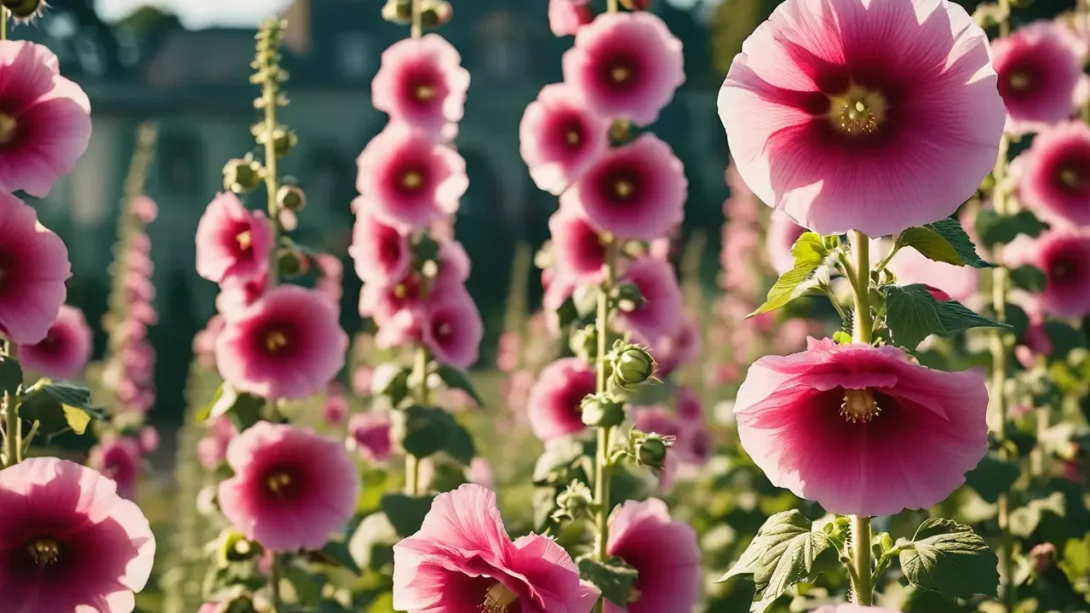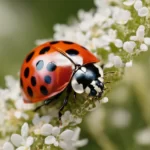Hollyhocks (Alcea spp.) stand as a timeless symbol of traditional cottage gardens, towering gracefully with their lofty spires of vibrant blooms. Originating from Asia and Europe, these perennial (sometimes biennial) plants have woven their way into the fabric of garden history and folklore, often associated with prosperity and survival. Today, hollyhocks are celebrated not only for their historical significance but also for their ability to add vertical interest and a splash of color to any garden setting.
Identifying Hollyhocks
General Characteristics
Hollyhocks are known for their impressive height, often reaching 5 to 8 feet tall, and in some cases, they can soar up to 10 feet under optimal conditions. Their growth habit is upright, with robust stems that may require staking in windy areas to prevent them from toppling over. The leaves of hollyhocks are large, with a heart-shaped to rounded form, and have a slightly coarse texture. They exhibit a deep green color, creating a lush backdrop for the flowers.
Flowers
The flowers of hollyhocks are the true showstoppers, presenting themselves in large, open blooms that can be 3 to 5 inches in diameter. They come in a wide array of colors, including white, pink, red, yellow, purple, and even black. The plants produce single or double flowers, depending on the variety, which bloom from the bottom of the stalk upwards, offering a prolonged display of color from mid-summer to early fall. Each flower, encircled by a ruffled margin, lasts about a week, but the overall blooming period can extend several weeks as new flowers continue to develop.
Stems and Foliage
The stems of hollyhocks are sturdy and covered with a fine layer of hairs, which can be slightly prickly to the touch. The foliage, arranged in a spiral along the stem, adds to the plant’s rustic charm. Leaves near the base are larger and serve to anchor the plant visually, while those higher up the stem become progressively smaller, drawing the eye upwards towards the blooms.
Varieties of Hollyhocks
Hollyhocks come in a multitude of varieties, each with its own unique appeal. The traditional Alcea rosea is perhaps the most well-known, offering single or double blooms that adorn garden backdrops with their old-world charm. Single-flowered varieties provide a more subdued elegance, with a single layer of petals revealing a central stamen, reminiscent of wildflowers. Double-flowered varieties, on the other hand, boast layers of ruffled petals that create a more opulent display, often resembling peonies or old roses.
Among the popular cultivars, ‘Chater’s Double’ stands out with its luxurious double flowers in shades of red, pink, yellow, and white. ‘Nigra’, also known as the black hollyhock, offers a dramatic flair with its dark maroon to black blossoms, a rare and striking color in the floral world. For those with limited space, dwarf varieties like ‘Majorette Mix’ provide a compact option, reaching only 2-3 feet in height but still delivering the classic hollyhock appeal with a mix of colorful double flowers.
Planting and Growing Conditions
To thrive, hollyhocks require full sun, meaning at least 6 hours of direct sunlight daily. They are not particularly fussy about soil type, but they do best in well-drained soil enriched with organic matter. Before planting, it’s beneficial to incorporate compost or well-rotted manure into the soil to improve its fertility and structure.
When planting hollyhocks, spacing is crucial due to their size. Individual plants should be spaced about 18-24 inches apart to ensure adequate air circulation, which helps prevent rust, a common fungal disease that can affect the leaves. Watering should be done at the base of the plant to keep the foliage dry and further minimize disease risks. Hollyhocks are biennials or short-lived perennials, so for a continual display, gardeners often plant new hollyhocks each year or allow them to self-seed in the garden.
Conclusion
Hollyhocks (Alcea spp.) possess an undeniable charm that can elevate any garden space. With their towering spires of blooms, they bring height, structure, and a burst of color that can capture the eye from afar. Their historical significance and the simplicity of their care add to their appeal, making them a beloved choice for gardeners aiming to create a nostalgic or cottage garden atmosphere.
The diversity of hollyhock varieties ensures there’s a type for every garden design, from the stately elegance of traditional Alcea rosea to the dramatic hues of ‘Nigra’ and the compact beauty of dwarf cultivars. By choosing the right variety for your space and providing them with the care they need, you can enjoy these majestic blooms from mid-summer to early fall.
Incorporating hollyhocks into your garden not only adds vertical interest but also invites a sense of history and continuity, connecting your garden to the generations of gardeners who have cherished these plants. Whether used as a backdrop for lower-growing flowers, a vibrant addition to a border, or as an architectural feature in their own right, hollyhocks are a testament to the enduring beauty and resilience of nature. Their towering presence and captivating flowers serve as a reminder of the simple joys of gardening and the timeless appeal of these classic blooms.



